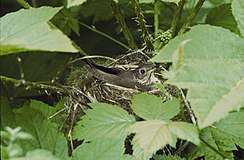Catharus
Catharus is a genus of birds in the thrush family Turdidae. It contains the small, mostly insectivorous or omnivorous migrant thrushes of North America and the nightingale-thrushes of Central and South America. Its closest relative is the wood thrush of the monotypic genus Hylocichla,[1] which is sometimes merged into Catharus.
| Catharus | |
|---|---|
 | |
| Gray-cheeked thrush (Catharus minimus) | |
| Scientific classification | |
| Kingdom: | Animalia |
| Phylum: | Chordata |
| Class: | Aves |
| Order: | Passeriformes |
| Family: | Turdidae |
| Genus: | Catharus Bonaparte, 1850 |
| Species | |
|
See list | |
These are mainly forest birds with large eyes, straight slim bills and fluty voices.
This is a typical New World thrush genus, although representatives of other genera, such as the true thrushes (Turdus) also occur in the region, especially in Central and South America. The breeding range of one species, grey-cheeked thrush, extends into Siberia.[2] The four North American species have all been recorded as vagrants in Europe on multiple occasions, and Swainson's and hermit thrushes have occurred as vagrants in northeast Asia.[2]
Systematics
The genus name Catharus comes from the Ancient Greek καθαρός (katharós) "pure" or "clean", and refers to the plumage of the orange-billed nightingale-thrush C. aurantiirostris.[3]
The Catharus species are either long-distance migrants or fairly resident birds. They were sometimes split according to this and morphological characters, the migrant group occasionally also including the wood thrush. Comparison of mtDNA cytochrome b and NADH dehydrogenase subunit 2 as well as nuclear β-fibrinogen intron 7 sequence data indicates that this is incorrect.[1] A later study by Gary Voelker and colleagues (2013) utilized 10 genes (two mitochondrial, two sex-linked and six autosomal) to compare the 12 species of Catharus and Hylocichla mustelina.
Due to the adaptational requirements of the independently acquired long-distance migrant lifestyle, several apparent morphological similarities between supposedly related species are actually due to convergent evolution. The genus colonized Central America shortly after the final formation of the Panamanian Isthmus. Subsequently, in tropical or subtropical forest ecosystems of northern Central America, species diverged to settle more northerly regions, subsequently finding themselves forced to migrate south in winter into more food-rich habitat. The most ancient of these northward divergences was probably Swainson's thrush, and the most recent one the fuscescens-minimus-bicknelli cryptic species complex.
Not only does the aurantiirostris-fuscater-mexicanus-dryas group form a distinct lineage, but so does the "bicknelli-minimus-fuscescens-frantzii-gracilirostris-guttatus-occidentalis" arrangement.[4]
Compared with the rest of species in "Catharus," Swainson's thrush has no close living relatives.[4]
The species are:
- Veery, willow thrush or Wilson's thrush (Catharus fuscescens)
- Gray-cheeked thrush (Catharus minimus)
- Bicknell's thrush (Catharus bicknelli)
- Ruddy-capped nightingale-thrush (Catharus frantzii)
- Black-billed nightingale-thrush (Catharus gracilirostris)
- Hermit thrush (Catharus guttatus)
- Russet nightingale-thrush (Catharus occidentalis)
- Swainson's thrush or olive-backed thrush (Catharus ustulatus)
- Orange-billed nightingale-thrush (Catharus aurantiirostris)
- Slaty-backed nightingale-thrush (Catharus fuscater)
- Black-headed nightingale-thrush (Catharus mexicanus)
- Gould's nightingale-thrush (Catharus dryas)
- Sclater’s nightingale-thrush (Catharus maculatus)
References
- Winker, Kevin & Pruett, Christin L. (2006): "Seasonal migration, speciation, and morphological convergence in the avian genus Catharus (Turdidae). Archived 2007-10-25 at the Wayback Machine" Auk 123(4): 1052-1068. DOI: 10.1642/0004-8038(2006)123[1052:SMSAMC]2.0.CO;2
- Brazil, Mark (2009) Birds of East Asia ISBN 978-0-7136-7040-0 page 400 – 402
- Jobling, James A (2010). The Helm Dictionary of Scientific Bird Names. London: Christopher Helm. p. 94. ISBN 978-1-4081-2501-4.
- Voelker, Gary, Rauri C.K. Bowie, and John Klicka (2013): "Gene trees, species trees and Earth history combine to shed light on the evolution of migration in a model avian system".